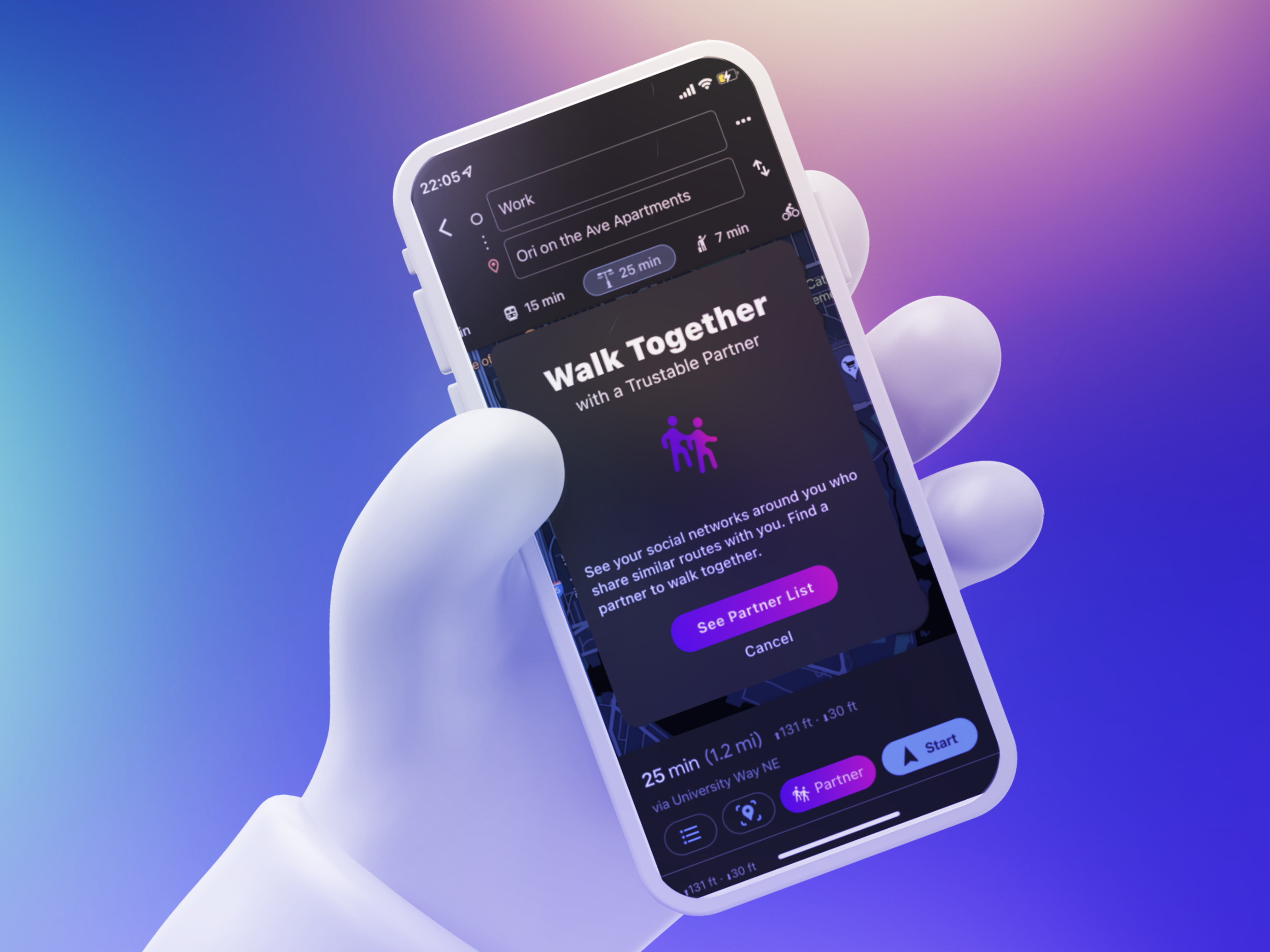
Night out

Night Out
A Digital service embed into Google Map that help women feel more comfortable walking alone at night.
Context
Night walk safety has been a communal concern for females. In Seattle and many other large cities in the US, many females are afraid of going out alone at night, but they shouldn’t have to be. In this project, we hope to find a solution that reduces the risk of going out at night and relieves the pressure for women and all feminine-presenting people who want to enjoy a safe night out.
My role & practices
UX Researcher & Designer
Survey & One-on-one Interviews
Affinity Diagramming
Design Sprint
Prototyping
Usability Testing
Tools
Post-it notes
Miro
Figma
Project Information
HCDE 518 Group Project
Time Span: 11 weeks
Google Map Redesign
Inclusive Design
Problem Space
Defining audiences and their goals
Our focused target users are women and feminine presenting people who walk alone at night in Seattle. Putting emphasis on encouraging people to freely express their gender identity, we also include people who present their gender in a more feminine way as our audiences. The goal of our audiences is to feel more comfortable to walk at night time.
Design Question
How might we help females, including feminine-presenting people living in Seattle feel more comfortable walking at night time?
Structured Design Process Model

User Research
Secondary Research/ Literature Review
At the beginning stages of understanding our design question, our team conducted a general search on the experience of women who ran into issues walking alone at night time. We also investigated different safety applications or tools that already exist. We felt that this secondary research method provided us with a foundational understanding to develop our design and survey questions.

*Secondary research of women night walking safety issue and its related applications.
Survey
In selecting our design questions, we wanted to get a general understanding of women’s experience walking alone at night, the activities that would require them to walk at night time and their information needs regarding safety. Therefore, a survey was designed to solicit a diverse range of responses from women who are currently living in the different neighborhoods of Seattle.




*1=very unsafe 5=very safe
Key Takeaways From Survey:
All respondents feel unsafe to walk alone after dark to a varying extent, and walking alone at night poses a threat to women is an undoubted fact. About 27% of respondents always feel unsafe to walk alone at night, 32% of respondents feel unsafe to walk alone at night most of the times, and 41% of respondents feel unsafe to walk alone at night sometimes.
Among different kinds of activities, “going out alone for exercising (jogging, walking, etc) at night” and “attending night events (parties, clubs, drinks, shows, etc) on yourself ” rank as the 1st most unsafe circumstance and the 2rd most unsafe circumstance respectively.
The top 3 measures being adopted by respondents to help them feel safer when walking at night are: (1) go with other people. (2) avoid going to dark corners and stick to lighted areas. (3) avoid going to unsafe neighborhoods.
Semi-structured Interviews
After collecting all the survey responses, the research team wanted to understand at a deeper level women’s experience of walking at night time, their general awareness of safety resources, their concept of safety, measures they have taken to protect themselves at night times, and what they would recommend to designers. We selected 8 interviewees out of the 44 responses we got from the survey to conduct a 45-minute semi-structured interview with one of the researchers to better understand our users’ experience. We thought the semi-structured one-on-one interviews would be the best method to solicit input from our main target user group and provide our target users with a comfortable space to share their thoughts and experiences.

* Key quotes from 8 interviewees.
Identify Themes From Qualitative Data
Theme 1: Internal fear of walking alone

Internal fears of walking alone was a common theme that came up for our participants during the interviews. Participants mentioned fears of being followed home, being yelled at by strangers, being approached by strangers, encountering and getting caught up in violent activities in their neighborhood.
Theme 2: The need to walk with someone

All of interviewees mentioned that they would feel safer if they can walk with someone else at night. The need of walking with other people becomes the most evident commonality among interviewees.
Theme 3: The importance of street light

Another theme is that interviewees have agreements on the importance of lights at night, and they tend to walk lighted areas and avoid going to dark place in the sake of safety.
Creating Persona
We came up with 2 personas based on real research data. One persona represents newcomers who are still relatively new and unfamiliar with Seattle, and another persona represents Seattleite who have born, lived or grew up in the Seattle. With different goals, frustrations, needs and self-protection measure, they properly covered and pictured our representative users and helped us to make design decisions later.

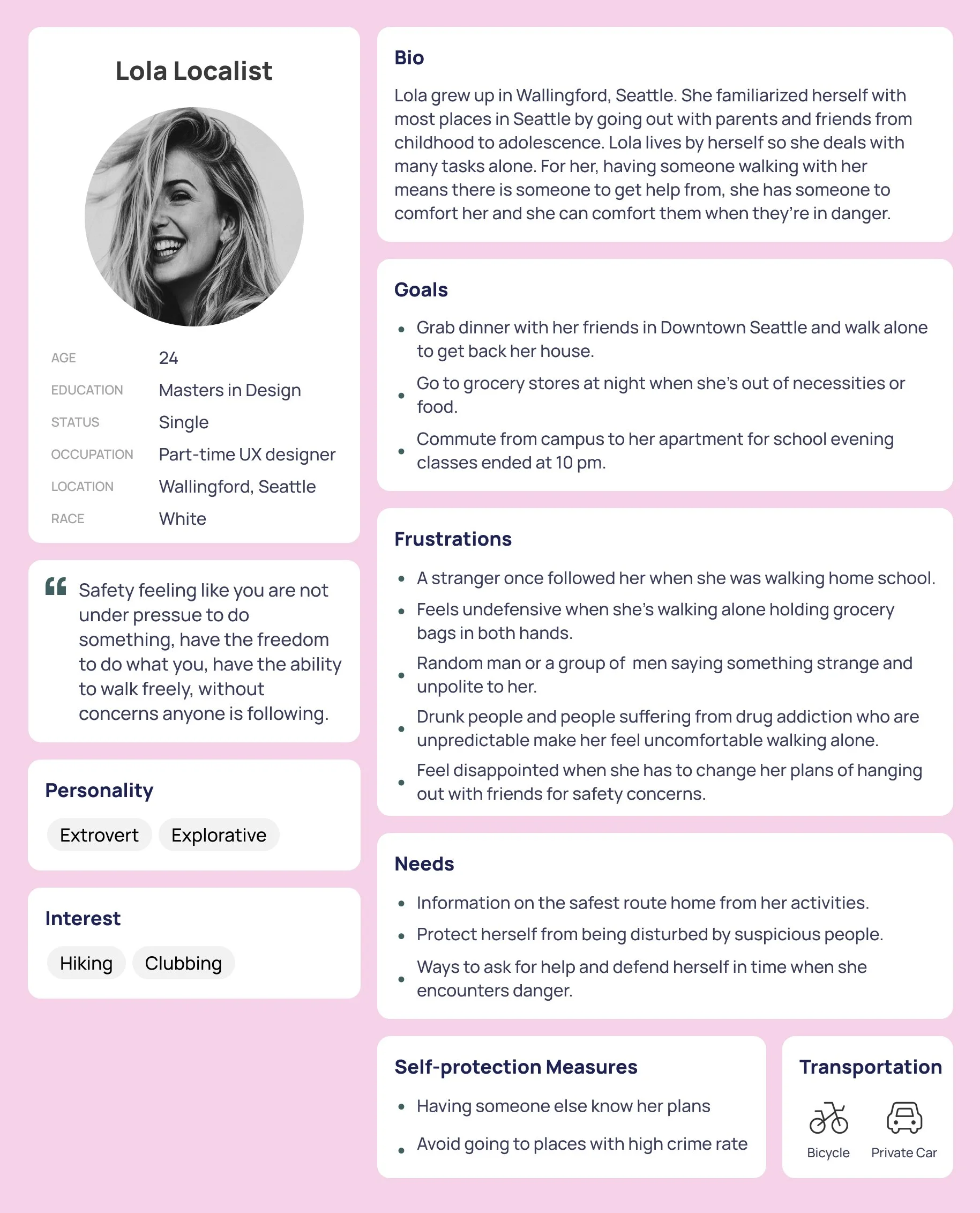
Design Ideation & Sketching
Design Sprint: Crazy 8’s
We are ready to start ideating! We used design sprint method “crazy 8’s” to challenge ourselves sketch 8 distinct solutions in 8 minutes.
We tried to generate as many as potential design solutions without considering too many restrictions at this stage. In the end, our team discussed and voted the most 2 feasible and popular solutions that we all have agreements to move forward, which are features “Safety Map” and “Walking Partner”.

* Rapid idea generations in Crazy 8’S
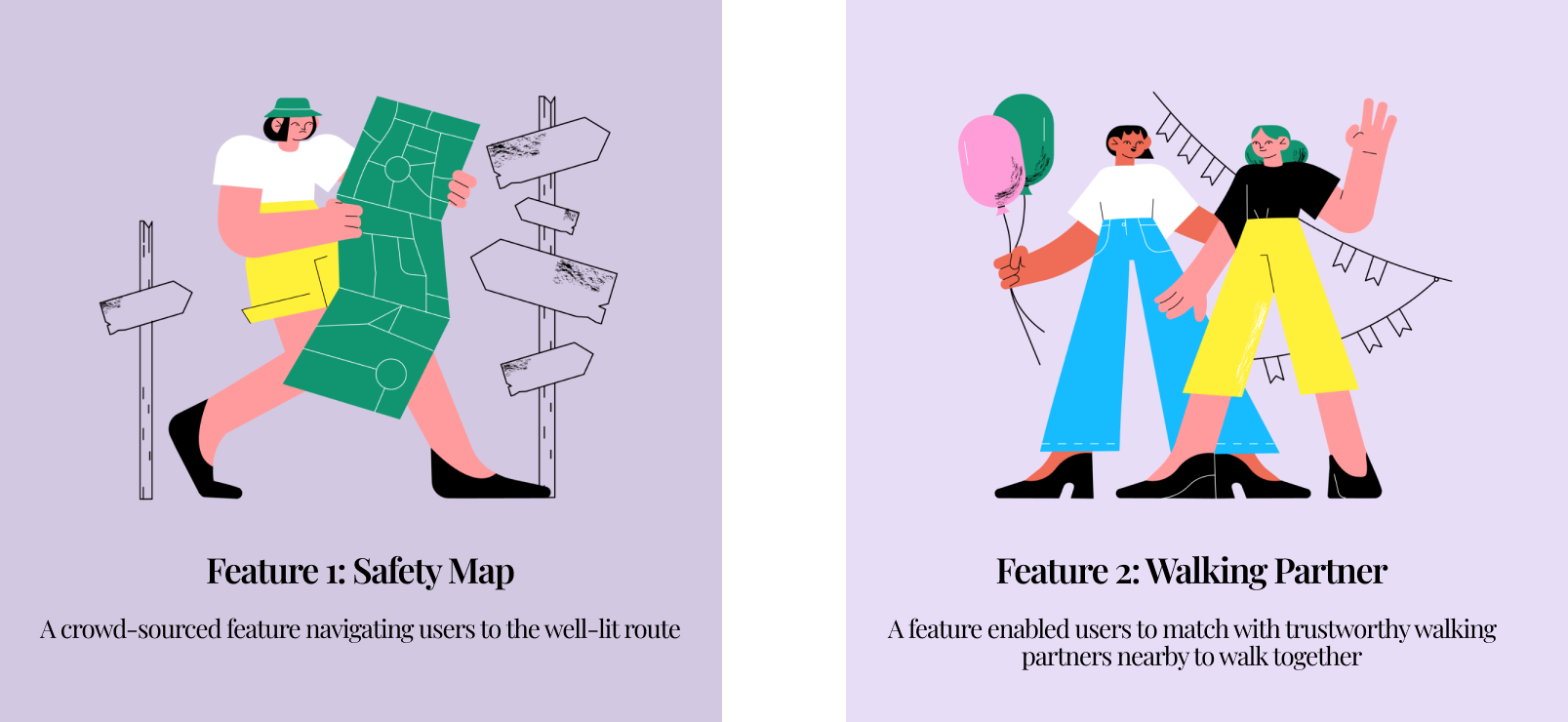
* 2 main feasible features the team came up after design sprint
Creating Storyboard
After we achieved consensus on main features of our product, we moved forward to use storyboard visually convey and depict experiences in the design process. Creating storyboard is helpful for us at this phase because it forces us to think about the user flow, and this inexpensive and quick technique posts little cost to no cost for us to reiterate.
Crafting user flow

The storyboard we created paved the way for us to really think of the user flow. Meanwhile, user flows we’ve finished helped us to understand the architecture and how all journeys tie to each other.


Challenges Begins
Challenge 1: A brand new app VS Digital service embedded in Google map
We were hesitant with the form of design deliverable we should go with. Usually, groups in this user-centered design class come up with a brand new app prototype as the final deliverable. However, according to our research data and observation, most of interviewees (6 out of 8) showed neutral or negative attitudes toward downloading and using a new safety app (eg, suspicion, discouragement). Digging deeper into interviews, I uncovered the root cause of their unfavorable attitudes in using new safety app are: (1) Too lazy to download new apps. (2) They have less motivation due to the “insufficient phone storage”.
Taken all those considerations, we forsook the commonplace idea, instead choose integrating features into a super app, Google Map.
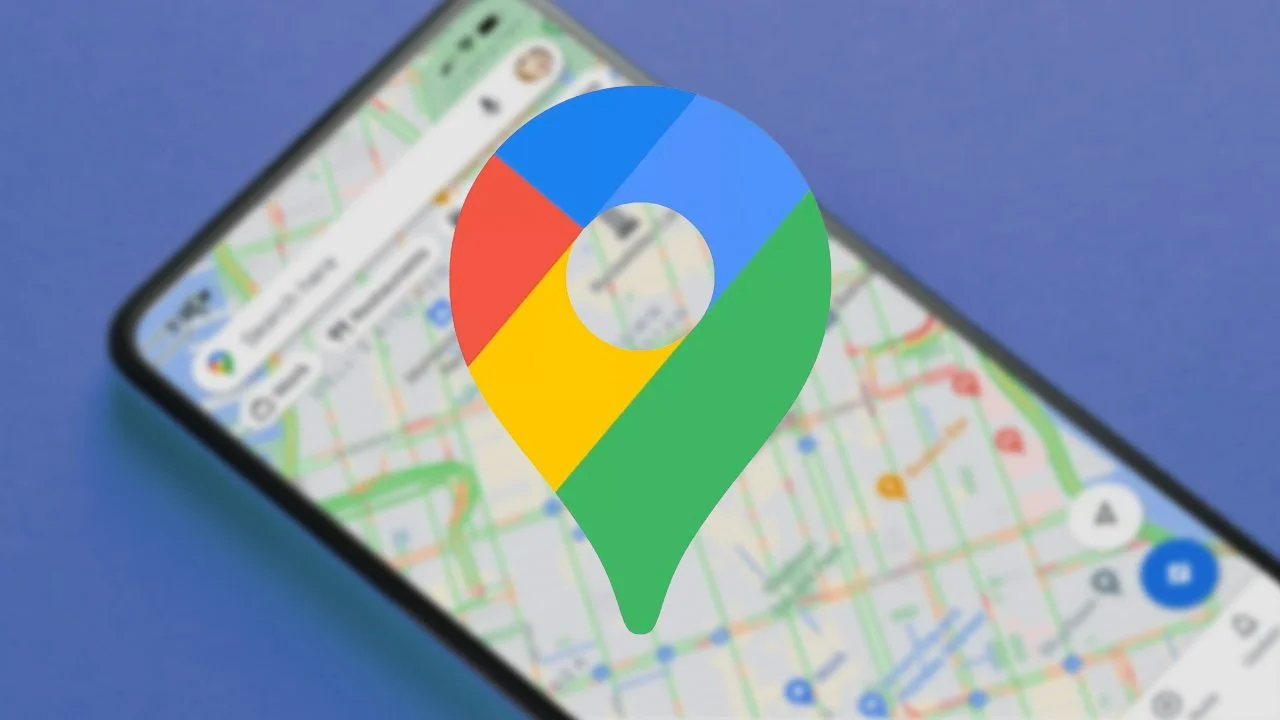
challenge 2 : How to build trust with users?
Although all interviewees have unmet need which is to walk with someone else at night and prevent from being alone, they do have concerns and requirements when we provide them space choosing walking mates. Most interviewees would only walk with people they know, or people from the same school, share same or similar social networks, otherwise they would feel unsecured or merely trust the product.
To Figma We Go!
Low-Fi Prototype & Key Task Flows

Design Principle

Core Design Decisions
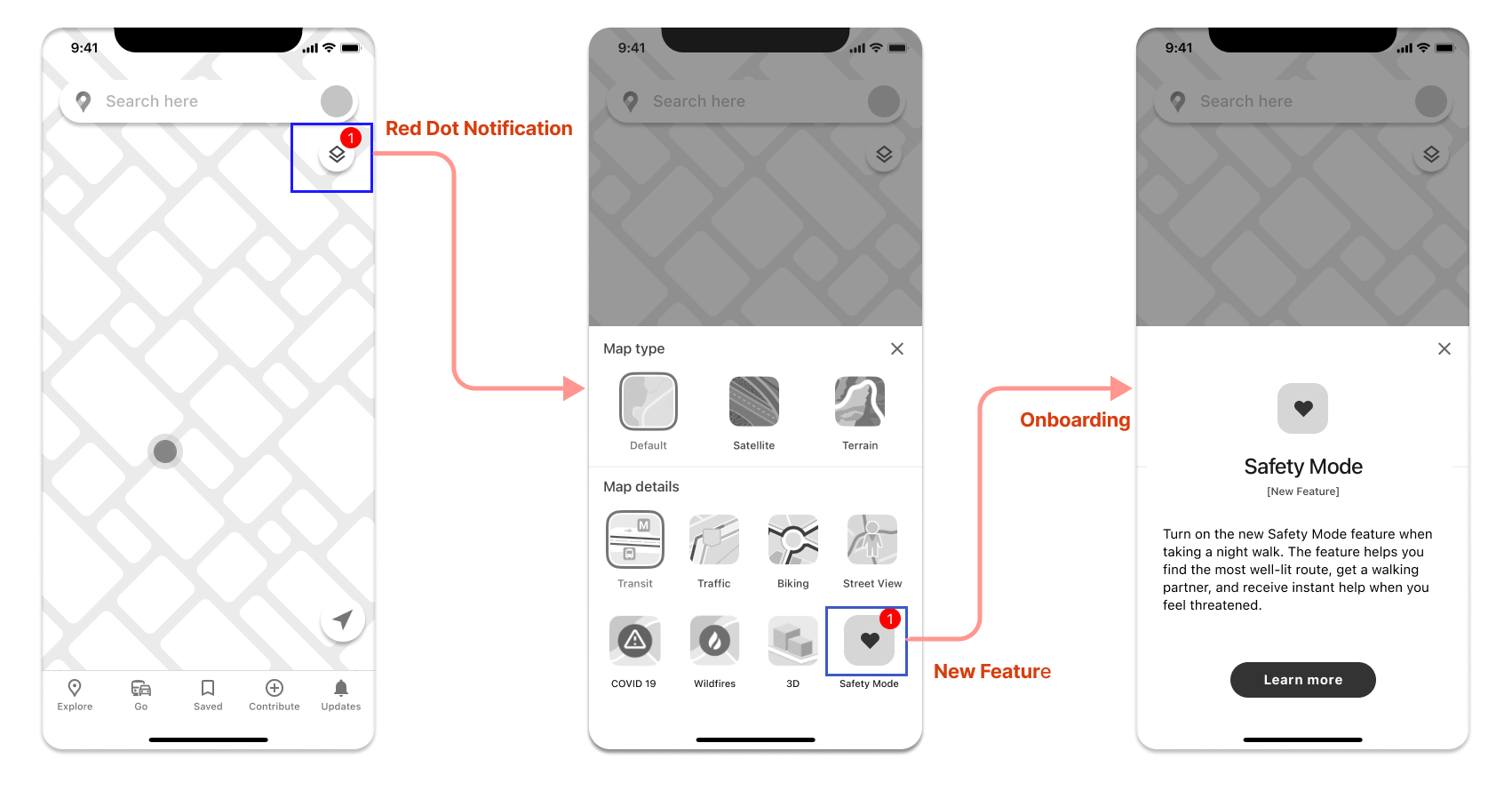
Onboarding:
Get rid of an intrusive boarding experiences, instead we designed in seamless way, designing the "red dot" icon in the layer icon to inform users new features while not interrupting them.
Finding walking mates:
Used the light bulb to represent well-lit route. At the bottom, we designed the entry-point for users to use the feature “walking partners”.

Designed tags for users to choose walking partners from same school, or share same social networks in order to lessen their uncertainties. We want to give users enough freedom and space to choose walking partners they feel trusted to walk with.
Usability Testing
After we done our first version of design, we wanted to evaluate our product by testing it with representative users. Thus, we decided to conduct usability tests on target users of the Nightout ‘Safety Mode’ feature in Google Map. We recruited 5 participants, and they were given 5 tasks to complete, meanwhile facilitators followed a script during the test.
Task Scenarios
Task 1 - On boarding of the new feature: Please find out the new feature of Google Maps and try to have a rough understanding of it.
Task 2 - Search route: Searching the well-lit route to get to your apartment Ori on the Ave.
Task 3 - Finding a night-walking partner: Finding a night-walking partner and rating the whole experience.
Task 4 - Insecure Situation: When you’re feeling very insecure, please find the safety button/emergency button to ask for help. Please make an emergency call.
Task 5 - Help neighbor in-need: You received a notification of a neighbor in need. Use our product to go help her.

* One participant of the usability test.
Testing Results
Metrics used to measure users’ performance on test tasks are:
Task success rate
The number of errors
Satisfaction ratings (1~5)
Since we adopted “think-aloud method” during the test, time for completing tasks is usually longer than users completing them in normal way. Thus,“task completing time” was not included as one of our metrics. Besides the three quantitative metrics, we also let participants to choose their most loved feature and least liked feature after the test ends.

Keep Design Iteration in mind
Social Media Connection Page (on-borading)

The well-lit route page

Walking Partner Matching Page

Final Design

The most-lit route
The crowdsourced UX mechanism provides night walk users with the safety protection of recommending well-lit routes. Users are able to avoid the dark alley, dim street light, and stay to the main street.

Onboarding
A smooth and quick on-boarding process for users to familiarize themselves the new feature “safety mode” embed in Google map.

A night walking partner
With the walking partner feature, the users will be able to get connected to people nearby who share a similar routes. They can choose appropriate walking partners by different filters.
Reflection
Taking users’ freedom and control into account, making sure consider users’ privacy and help them make their judgement. As a human-centered designer, I should always provide users more space, but not make them feel obliged to do certain actions. Meantime, we need to test ideas iteratively and never assume users’ thoughts or preferences without testing the prototype.
Always make design aligned with users’ mental modeI. It is important to leverage users’ knowledge of familiar items or things in the real life on my design. The payoff is smoother interactions and better overall usability.
